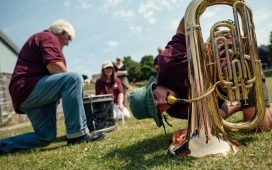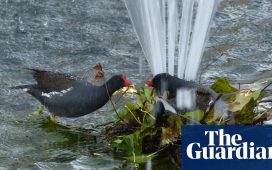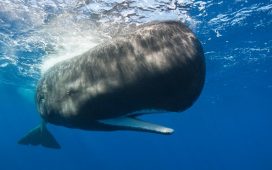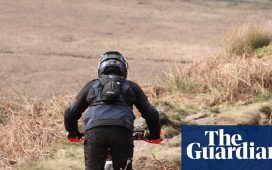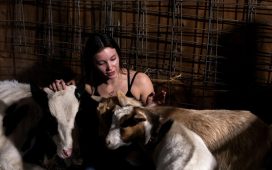The sun has set south-west of Brisbane and Linda Kimber marches off into a paddock dragging a shopping trolley lined with plastic behind her and shining a head-torch in front.
Metres to her left, Jo Davies walks a parallel trajectory into the gathering gloom, also carrying a customised carrier – hers a large dog-biscuit bag slung on rope with a downpipe offcut protruding from its sealed top.
Joan Sheldon, to Kimber’s right, completes the human chain, carrying a bucket. The women methodically shine their lights beneath shrubs, beside puddles and, especially, on cowpats.
European lords hold stag hunts, the Inuit chase whales beneath waves and ice. Kimber is leading a quintessentially Queensland search. This company of women are on a toad hunt.
They are not alone. Across three states and a territory, a small army of Australian volunteers is embarking on a week-long event dubbed the Great Cane Toad Bust.
Now in its second year, it is a competition which is taken deadly seriously around the town of Boonah.
Kimber’s group – WACT (Women Against Cane Toads) – are the defending local champions, having caught 928 of the district’s 9,468 toad tally in last year’s Bust.
“Many of the ladies were a bit squeamish at first,” Kimber says. “But it got to the stage where it was really hard to go home if you didn’t have 150 toads.”
Deliberately brought from Hawaii in the 1930s, the cane toad has since become a poster child of an introduced animal going rogue.
As the invasive species continues its spread, it decimates predators naive to its toxins and devours just about anything it can fit in its mouth. And it is not just wreaking devastation on other species.

While the toad has shown little appetite for the cane beetle that sugar growers originally hoped to control, it does consider the dung beetle a delicacy. This means more cowpats left in paddocks, exacerbating fly and parasite problems among cattle and reducing the nutrients being returned to soils.
Chris Bonner, on whose farm the women hunt, speaks for almost every Queenslander when he describes his sentiment towards the big, warty amphibian.
“It’s public enemy number one,” Bonner says.
On the frontlines of its march down into New South Wales and across into Western Australia, cane toads can form writhing carpets as they explode into new territory.
But the toad has been established across the eastern seaboard of Queensland for decades – and so too, toad busting.
“You wouldn’t be a kid in Queensland if you hadn’t hit a few toads with a golf club,” Kimber says.

But that’s a cruel technique she neither condones nor abides. Her hunters use only the most humane way of destroying their quarry: the fridge-freezer method.
After 24 hours in the fridge, the cold-blooded creatures slip peacefully into a state of torpor. The freezer induces sleep from which they never wake. This leaves the obvious problem, though, of what to do with so many frozen toads.
“We emptied a 120 litre freezer three times in a day last year,” Kimber says.
Emily Vincent from Watergum, the not-for-profit organisers of the Toad Bust, recommends that keen participants take the matter into their own hands.
“If toad busting is something you enjoy, an extra toad fridge-freezer in your garage is definitely a worthwhile investment,” she says.
But Watergum has established permanent drop-off stations in south-east Queensland where people can dispose of toads year-round.
From these toads the environmental charity extracts poison glands which it uses to make bait for tadpole lures. Watergum is beginning to roll out these traps commercially in an effort to turn the tide against this invasive species.

But Vincent is under no illusions. No amount of human endeavour will ever eradicate the cane toad, of which scientists estimate there’s more than 200m in Australia today.
“They’ve been here 90 years,” Vincent says. “Australia is a very big, often inaccessible country, we are too far gone for that.”
Thankfully, a growing number of species are learning ways to safely eat toads, while others become resistant to their toxins.
The Great Cane Toad Bust, Vincent says, is about buying nature more time to deal with this problem in her own way.
“Native species, one day, will be able to manage cane toads on their own,” she says.
“But, for now, if the cane toads continue to multiply and multiply, we run the risk that they are going to overwhelm our native species.”
And the anecdotal evidence shows toad busting can help control local populations. This year, the women of WACT are getting dozens of toads where last year they bagged hundreds.
That’s partly to do with a cooler summer – but their organised efforts can’t have hurt.
And besides, says Jo Davies, it’s the right thing to do. Initially, the Boonah woman says she was uncomfortable with the ethics and practicality of killing toads. But now, spotting the unmistakable silhouette of a cane toad, she places a Doc Marten deftly upon its back, plucks a hind leg and coolly drops the toad down the pipe and into her dog-biscuit bag.
“This is a mistake that humans made,” she says. “We all see this as our offering back to nature.”



